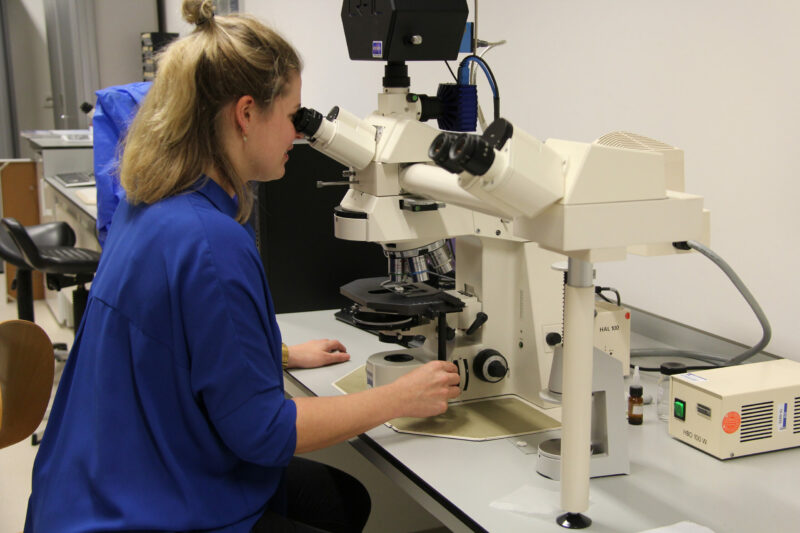TU Delft researcher Birgit van Driel has developed a testing method to estimate the potential risk of the possibly unstable pigment titantium white to paintings.
Titanium white is a pigment used in the 20th century by painters like Picasso and Mondriaan. The ‘bad’ version of this pigment can lead to early aging of paintings when expowed to UV light. Birgit van Driel has collaborated closely with AkzoNobel and, under the umbrella of the Netherlands Institute for Conservation+Art+Science+ (NICAS) with the Rijksmuseum and the Cultural Heritage Agency of the Netherlands, to develop a straightforward method to estimate the potential risk to painting. This will enable museums to take timely action to prevent damage to paintings. On Wednesday 9 May 2020, Birgit will be defending her PhD at TU Delft.
Birgit van Driel: ‘Although degradation happens more slowly than we expected, and titanium white pigments were adopted later in the Netherlands than we thought, works that contain titanium white still constitute a risk for modern art collections. There is currently very little understanding of this in the modern art world. My research can help ensure that art works that contain titanium white can remain undamaged in the future, by adopting the attitude that prevention is better than cure.’
Titanium white
Birgit van Driel conducted research on the photocatalytic degradation of oil paintings containing the titanium white pigment. Titanium white pigments (based on titanium dioxide) were introduced to the market in 1920, and can be found in works by artists including Picasso, Mondrian and Jackson Pollock. If no action is taken, the white pigment is certain to age the painting in the long term, causing the work to lose intensity, colour and lustre. This ageing is caused by ultraviolet (UV) light.
Good and bad pigment
‘There is a wide range of titanium white pigments, with different properties. This range includes ‘bad’ pigments, that can accelerate UV degradation, but also ‘good’ pigments, that can prevent or slow it down. Both ‘good’ and ‘bad’ pigments were used in paintings. In the bad variant, radicals can be formed through exposure to UV light, as a result of which the binding medium (polymerised drying oil) is broken down into separate components, causing chalking: the pigment separates on the surface of the paint.’
Unnoticed
Van Driel investigated the chemical and physical changes that occur before the change becomes visible. Accelerated ageing experiments involving simple pigment oil paints revealed that the chalking happens suddenly and quickly. Chemically speaking, it is therefore likely that degradation is already taking place, but that it takes a long time for the problem to become visible. Van Driel used a range of analytical techniques,, enabling her to identify different changes that can be monitored in order to detect degradation at an early stage.
Straightforward test
To help museums and private collectors recognize the presence of the bad version of titanium white, Van Driel developed a straightforward and cheap predictive test for restorers. The test, originally developed to analyse self-cleaning tiles and glass, uses photocatalytic activity indicator ink. If a bad pigment is present, the ink colour changes and this can be observed easily using a microscope. The method is local because only layers of paint in which the pigment is present change colour. Van Driel: ‘This makes it a straightforward test for quickly identifying paintings that are vulnerable. For the first time, we solved a problem that had not yet even visibly manifested itself.’
Preventing degradation
Now that an effective, straightforward and low-cost test is available, Van Driel believes that it is essential that museums with modern art and private collectors make a start determining the vulnerability and value of the works in their collection. Based on the works’ potential risk, the composition of the collection and its aim, corrective measures can be taken, such as storing objects in the dark or reducing UV radiation at building or object level.
Need for more cooperation
As a result of this research, Van Driel and her promotor Joris Dik, urge for more cooperation with museums in this type of investigation into complex degradation resactions in modern art. Only this way, preventive measures can be taken to better preserve our modern art collection.
Birgit van Driel’s PhD research was conducted in partnership with the Rijksmuseum and the Dutch Cultural Heritage Agency (RCE). AkzoNobel also provided financial and substantive support. The project is a NICAS partner project.
More information
- PhD defence Birgit van Driel ‘Titanium white, Friend or Foe? Understanding and predicting photocatalytic degradation of modern oil paintings.’
- 9 May 2018, 15:00 hrs, Aula, TU Delft
- Promotors: Prof Joris Dik (TU Delft) and Prof Klaas Jan van den Berg (UvA).

